Text
Another wireframe update
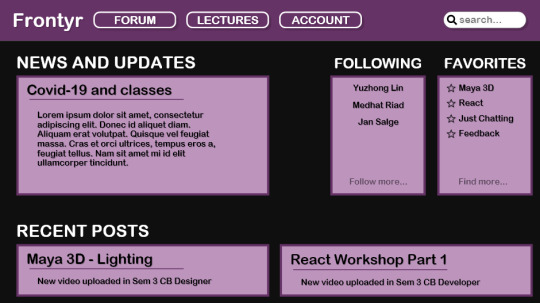
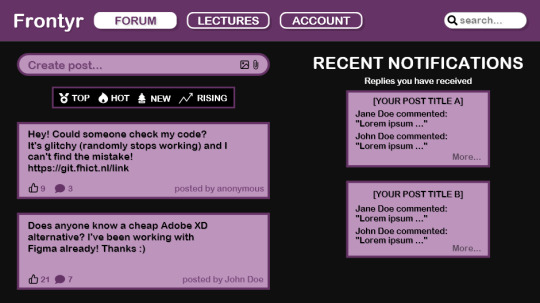
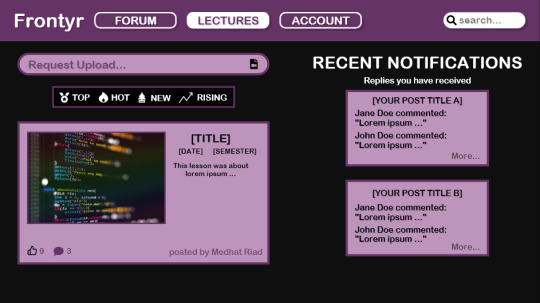
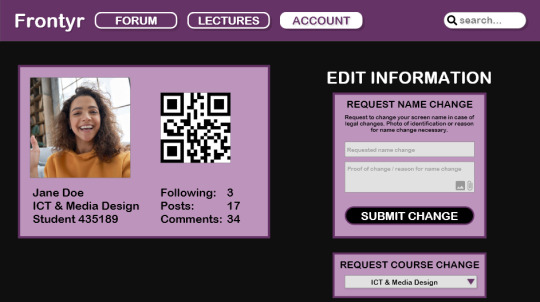
https://xd.adobe.com/view/ced3a896-3562-43ca-8383-0cd7f6a55a7a-9b80/
0 notes
Text
Newer version of Elin’s wireframe
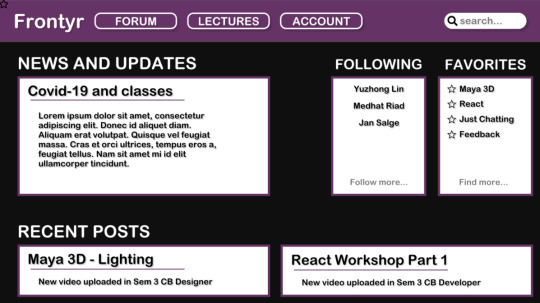
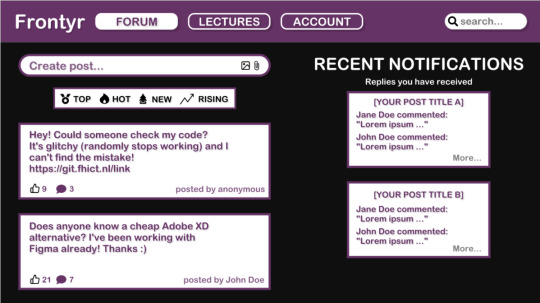

https://xd.adobe.com/view/ced3a896-3562-43ca-8383-0cd7f6a55a7a-9b80/
0 notes
Text
example of good devblogs
https://www.positech.co.uk/cliffsblog/
https://rust.facepunch.com/blog/
https://www.factorio.com/blog/
0 notes
Text
Link to GIT repository
https://git.fhict.nl/I448620/shadowwalkers-project.git
0 notes
Text
APIs and Integrations
What are APIs?
Application Programming Interface, APIs are softwares that enables two applications to communicate with each other. It is done by connecting a website or an application with databases. APIs also allows third party developers to access databases from other applications.
General pros and cons of using APIs
Pros:
- Very efficient. Since it generates all information automatically from the database.
- Allows developers to easily embed content from other sites and applications into their project
Cons:
- API programming requires extensive programming knowledge.
- API implementation can be costly.
How could an API be beneficial for our project?
For our project, using the Fontys API can make our application very easy to use since it will use Fontys log-in information. This will allow the students to download the application and use it without having the need to create a new account. As well as for us the developers we can access all the information needed, and this will save us time and effort when developing.
Integrations. How can we integrate our project into Microsoft teams or Canvas?
First things first, before integrating any application there are a lot of things to consider. As for integrating into Microsoft Teams. They have a webpage explaining in detail about all the prerequisites.
https://docs.microsoft.com/en-us/microsoftteams/platform/samples/integrating-web-apps
As for canvas integration, there is a video explaining LMS Canvas integration in detail.
https://www.youtube.com/watch?v=NvspNXhBXNk&ab_channel=CengageLearning
How would integrating our project into MS Teams or Canvas be beneficial to the users or developers?
By integrating our project into Microsoft Teams or Canvas it will benefit our users and improve on our project’s user friendliness drastically. Since Fontys students are already familiar with both Microsoft Teams and Canvas, integrating our project into any of those two applications means student will not have to download any additional applications or launcher to use our application. This reduces the chances of errors as well as confusion from the student’s side. So, by integrating our project we intended to make the customer journey of our users easier and more familiar.
0 notes
Text
Wireframe (just for fun tbh)
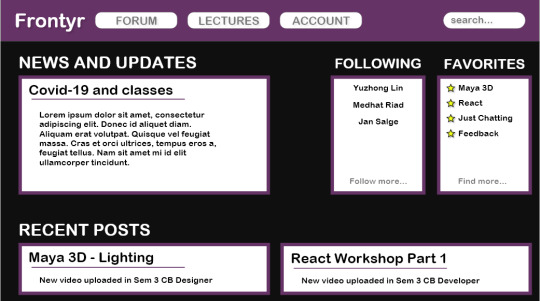
https://xd.adobe.com/view/ced3a896-3562-43ca-8383-0cd7f6a55a7a-9b80/
0 notes
Text
Received questoinnaire answers
Click on Read More to see all results
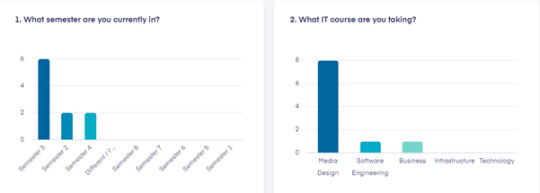
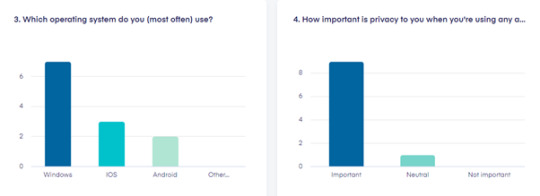
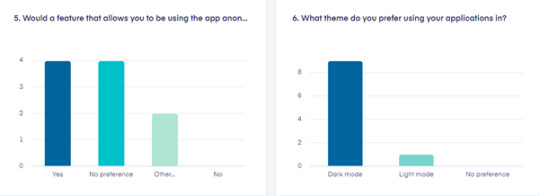

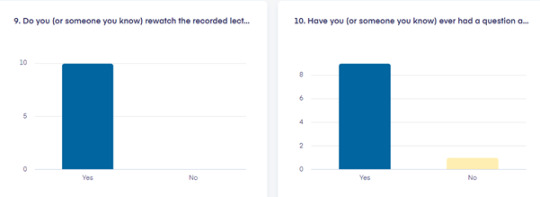
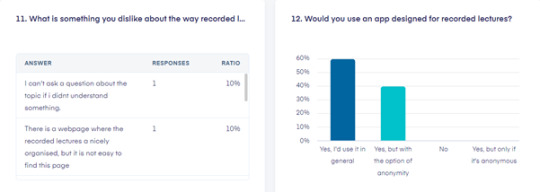

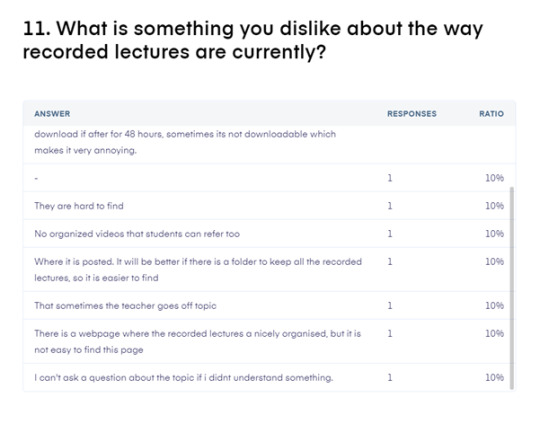
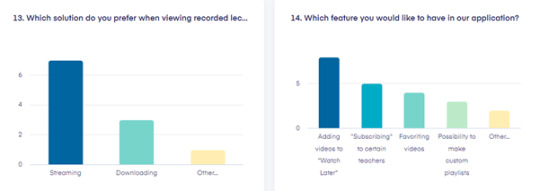
0 notes
Text
Research about social anxiety
This was also handed in by me (Elin) as an assignment for Influencer
Keywords: social anxiety, social media, mental health and well-being.
Our project preaches about how we can help students with fears such as the social anxiety disorder, but before getting into why it can be so important, let’s see what social anxiety even is and how to help it as a teacher first.
According to ScienceDirect.com3 (2001) it is also known as “social phobia”, social anxiety is characterized in anxiety disorders by the very strong need to make a good impression of oneself on other people, lathered in insecurity in their ability to actually do so – meaning that somebody wants people to think good things about them, but doubting if they are actually able to make somebody like them. People with this phobia tend to avoid scenarios where they can trigger negative feelings from others towards oneself, or if they do allow themselves in those scenarios, it’s often mixed with distress and anxiety. People with a social phobia like this have all sorts of different reactions, such as blushing, nausea, hand tremors and trouble concentrating – these can progress to something more serious as a full blown panic attack, via ScienceDirect.com5 (2008).
ScienceDirect5 (2008) also states while it does and has been mistaken for simple “shyness”, social anxiety is rooted much deeper into ones personality and every day life. It can be an early age onset and risk factor for depressive illness, drug and alcohol abuse. It’s not unusual for the person to recognize that the fear is excessive, however they cannot help to hide away from confrontations that possibly embarrass them.
Social networking can help people with social anxiety to easily initiate and establish social connections, it can make it less intimidating by texting in the safe environment of your home. Social media can give you the place to talk about whatever you like, about however you feel and to whoever you want; even if that person is just someone you don’t know on the other side of the world. Platforms that allow anonymous posting can allow these people to feel less alone and think of their disorder in a less negative light (VeryWellMind.com2, 2020). Sadly, there is always negatives to positives. People with social anxiety are more vulnerable to an internet addiction (Weinstein6, 2015) – along with the higher chance of developing substance abuse later on.
As stated before, people with social anxiety stay away from situations which can lead to them being embarrassed – including asking questions as a student. Luckily there are things teachers can do to slowly but surely help this student gain more confidence along the way, and TheMighty.com4 (2017) has given us multiple options. Easy things as just small praises for their accomplishments, rewarding participation even thought that student is wrong, gently encouraging the student by also speaking in a soft, calmer tone. If you’ve noticed, as a teacher, that one of your students has been acting more anxious than as per usual: approach them, talk to them, lift that weight off their shoulders by taking the first step – as that’s often all it takes for somebody to open up. Feel free to thank VeryWellMind.com1 (2020) for some of these tips, teachers!
For the future, I can research way more about other fear inducing factors (such as past traumas when it comes to being curious), but also possibly differences in culture or just the way someone was raised when it comes to asking questions, or ways to go against social media addictions.
1. Cuncic, A., & Gans, S. (2020, 13 januari). How Teachers Can Help Their Students With Social Anxiety Disorder. Verywell Mind. https://www.verywellmind.com/teaching-students-with-sad-3024340#:%7E:text=How%20to%20Treat%20a%20Student,feared%20situations%20with%20gentle%20encouragement.
2. Cuncic, A., & Morin, A. (2020, 29 juni). How to Make Social Media Work for You With Social Anxiety Disorder. Verywell Mind. https://www.verywellmind.com/social-network-use-and-social-anxiety-disorder-4117143#:%7E:text=Social%20networking%20sites%20may%20help,the%20house%20is%20an%20issue.
3. Purdon, C., Antony, M., Monteiro, S., & Swinson, R. P. (2001, 1 mei). Social anxiety in college students. ScienceDirect. https://www.sciencedirect.com/science/article/abs/pii/S0887618501000597?casa_token=KOxFrb9P3DkAAAAA:nqVspnhSmWpIgi3zkJptuau0ty9kyShO3AHkfT0wxayTsNPAtA1IYftkQNJCNAwNyUWSYFBX2w
4. Reid, C. (2021, 16 april). How Teachers Can Help Students With Social Anxiety. The Mighty. https://themighty.com/2017/09/how-teachers-can-help-students-with-social-anxiety/
5. Stein, M. B., & Stein, D. J. (2008, 29 maart). Social anxiety disorder. ScienceDirect. https://www.sciencedirect.com/science/article/abs/pii/S0140673608604882?casa_token=my7tNJSmSjcAAAAA:wtdALwNX4sllJl7uns1IxEU9wD_0quWP48HzsHMOEMySyu1HtFBPaL-KjmO05WbzPwc6BfwQ3A
6. Weinstein, A., Dorani, D., Elhadif, R., Bukovza, Y., & Yarmulnik, A. (2015). Internet addiction is associated with social anxiety in young adults. ResearchGate. https://www.researchgate.net/file.PostFileLoader.html?id=555bdefc5f7f715c608b459e&assetKey=AS%3A273780113379329%401442285673262
0 notes
Text
Updated Project Concept
Project Concept 2.0
Made by the Shadow Walkers: Aflah, Dylan and Elin
(click on keep reading to see the entire file)
Introduction:
As a group we have come together to make the base of our idea broader, more visual and more structured. Through analysis of the previously created concept ideas, feedback we have received and research we have done, we’ve made the decision to combine our ideas of “Recorded lectures web app” and “Somewhat anonymous Fontys ICT forum”. We’ve been refining this concept over the last few weeks, which you will read throughout this file.
Concept:
Story:
There are plenty of students who struggle to ask for feedback, ask questions during lectures or ask for help in general. We’ve recognized this problem and brainstormed how we could possibly help out, but also learn more about the root of the problem. Our team consists of students and we hope later on professionals will join in. We came up with a resolution to the issues of some students. Our business gives students the ability to go anonymous and ask whatever they want about any project, idea or mindset (relating to the study courses) with an added benefit of watching previously recorded lectures. We understand the issues students can have when it comes to asking questions, and we are working hard to create a space to help as many people as possible and give them that platform needed to communicate and grow as an ICT student, without the hassle of small talk, anxiety, overthinking and shame.
Concept description:
Our concept is a web application for students and teachers on Fontys ICT to interact, discuss, ask questions and grow with other ICT students – giving them the ability to post questions and answers anonymously on the platform. Within the web app there is also the possibility to watch recorded lessons and workshops easily, dividing them into clear, identifiable groupings with the help of tags. This way students can stream the recorded lessons and ask a question if they do not understand something or generally have questions about said lecture. To ensure a safe platform, we want as little information about the student, but plenty enough for the school to have repercussions if a student bullies or harasses others on it. With that, we highly encourage the possibility of moderators to go through posts, replies, videos, etcetera.
Goal and target group:
Our goal is to improve online learning and make it easier to help students when they have questions and difficulties without possible added anxiety.
Our target group are Fontys ICT students, but Fontys ICT teachers are also encouraged to use it.
Personas:
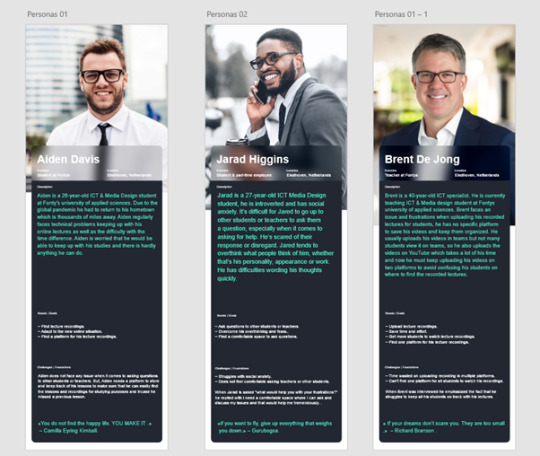
User scenario / Empathy map:
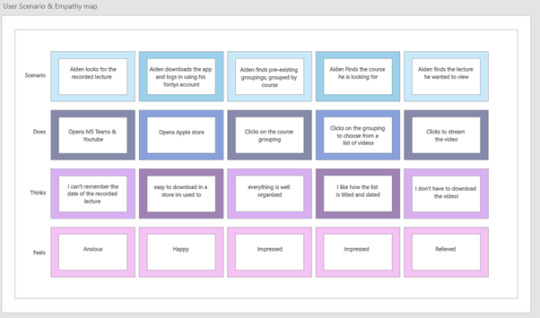
MoSCoW:

Must have
· Anonymity possibility
· Video (class recordings) uploads
· Forum to discuss / ask for feedback
· Dark mode
· Streaming option for videos
Should have
· Fontys ICT email account verification
· Comment section for the videos
· Playlists (such as favorites and watch later)
· Hashtags to find certain videos
· Different forum ‘sections’ per specialization
Could have
· Mobile applications
· Downloadable videos
· Moderators for the forums and video uploads
· Option for light mode
· Students putting recorded lectures in a queue so teachers just have to accept the video to upload it
Won’t have
· “Pay to view”
· Excessive personal information for registration (Fontys email and full name should be plenty to know)
POV:
Fontys ICT students need a platform that holds the possibility to make it easier for them to study, grow and receive feedback.
HMW:
How might we make students use our service? How might we guarantee the anonymity of users? How might we make it so watching recordings is clear for the user? How might we make sure that students benefit from our service?
Business Canvas:
We have a written out business model canvas, it’s a clearer story to remember information. We can model it differently if necessary.
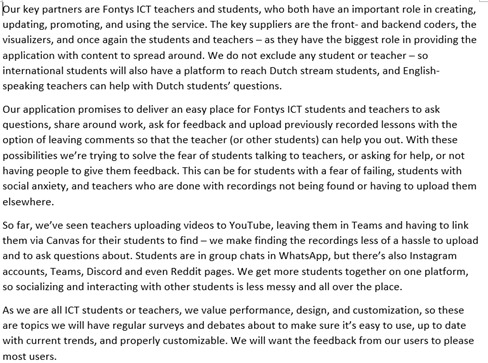
Why it is good and why it matches the briefing:
The concept that we came up with is a mix between two concepts that we showed in the briefing in sprint 1. We came to this conclusion because we thought that both ideas could easily be combined into one helpful concept. Therefore we think that our current concept matches what we wanted to do with the original ideas and made changes to make it easily convertible into one application.
As to why it is good, is because it will allow us to not only test our skills in making this application a reality, but we are also giving our target group, Fontys students, a way to have easy access to all recorded lessons and have a source where they can ask questions that they may have, whether it’s a question on a video or a question that has to do with something else. All be done anonymously, but that is an option.
Visualization of the concept in sprint 2:
https://youtu.be/9IkmMAZtoEI
Visualization of the concept in sprint 3:
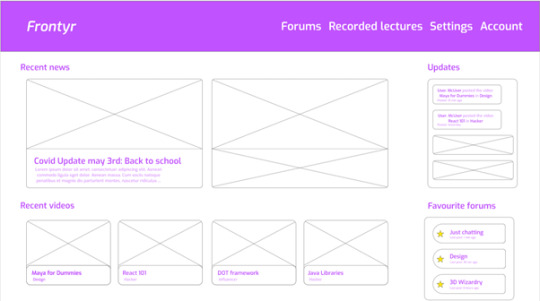
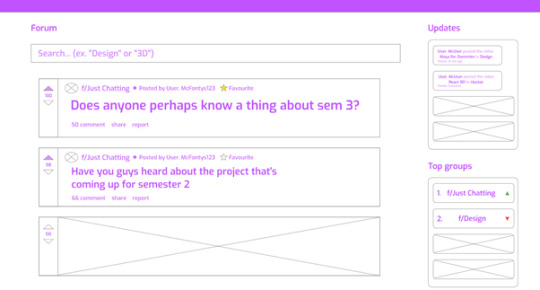
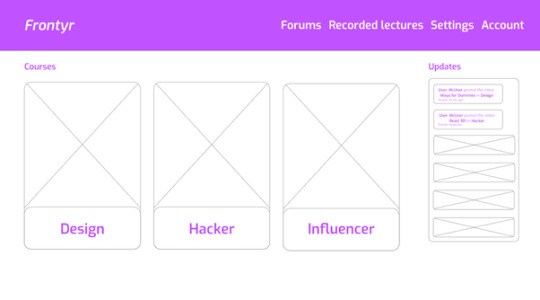
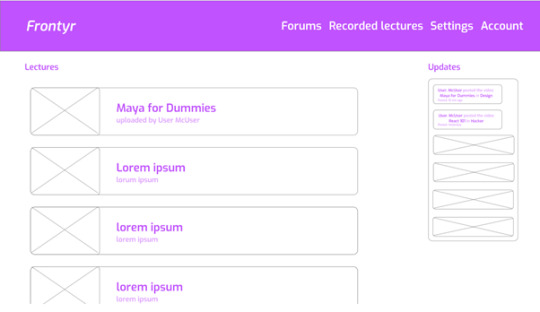
0 notes
Text
MoSCoW

Must have
· Anonymity possibility
· Video (class recordings) uploads
· Forum to discuss / ask for feedback
· Dark mode
· Streaming option for videos
Should have
· Fontys ICT email account verification
· Comment section for the videos
· Playlists (such as favorites and watch later)
· Hashtags to find certain videos
· Different forum ‘sections’ per specialization
Could have
· Mobile applications
· Downloadable videos
· Moderators for the forums and video uploads
· Option for light mode
· Students putting recorded lectures in a queue so teachers just have to accept the video to upload it
Won’t have
· “Pay to view”
· Excessive personal information for registration (Fontys email and full name should be plenty to know)
0 notes
Photo
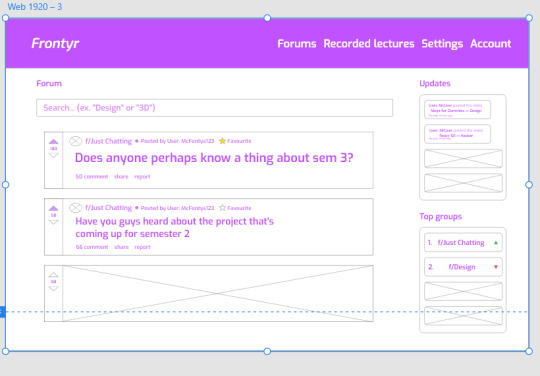
last photo 3 updated. For now inspiration has been drawn from reddit. this will be changed according to given feedback and possible ideas from our target group
0 notes
Photo
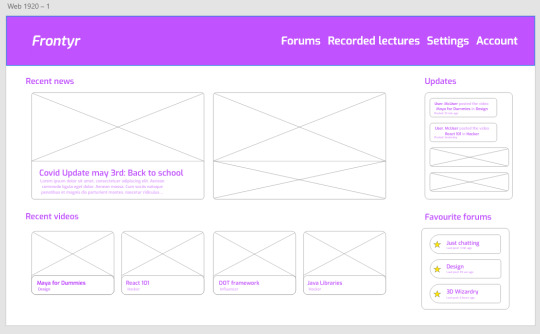
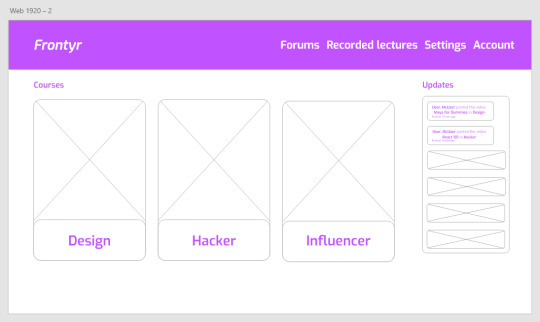
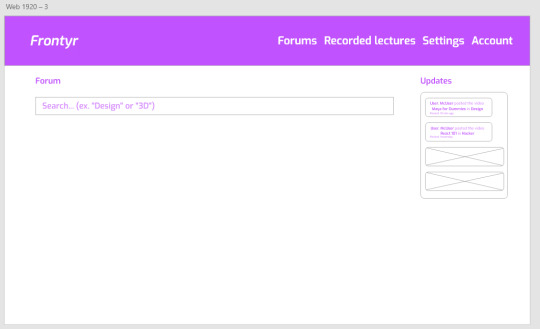
Photos of the first wireframes of the 1st design. Photo 3 is still in progress.
0 notes
Link
1st concept visualisation.
posted: 15 april 2021
0 notes